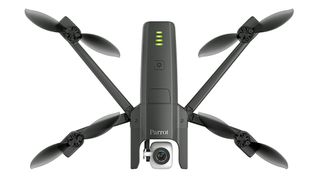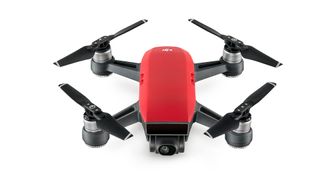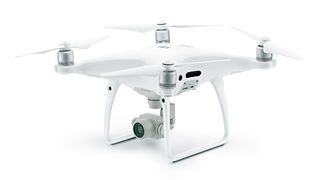Drone technology is advancing so fast that it’s an expensive business just trying to keep up. No sooner have you bought your lovely DJI Mavic Pro when along comes the much smaller, slightly cheaper and just as capable Mavic Air. Honestly, DJI is so far ahead of the curve, it’s a wonder other manufacturers even bother to compete.
The new Mavic Air is a true pocket rocket that excels in every department. It’s quite a bit lighter and smaller than the DJI Mavic Pro (168mm in length against 198mm) and not much bigger than its smaller sibling, the Spark. Figure in the four folding rotor arms and what you have here is the most portable 4K camera-equipped drone currently on the market.
The 4K video quality from the Air’s robust 3-axis camera system is generally on a par with the larger Mavic Pro while its 12mp photos are arguably more detailed and blessed with better contrast. It can also take four styles of panorama images and it does this all by itself. Simply select the panorama function and the drone hovers in one spot while it takes a series of images from different angles (with no pilot input) which it them stitches together to produce a seamless widescreen vista.
Like the Spark – and to some degree the Mavic Pro – the Air can also be controlled with palm gestures or a mobile phone; handy additions for those times when you can’t be bothered to dig out the supplied hand controller. That said, flying with the hand controller is far and away the most satisfying way to operate it. It also lets you fly much further – up to 4km (2.48 miles) away and back again on a battery that lasts around 21 minutes.
The Mavic Air’s hand controller is smaller than the Mavic’s and it doesn’t come with an LCD screen so you’ll need to rely solely on the data and picture feed to your smartphone or mini tablet. But that’s no big issue as long as your mobile has enough battery.
The element I love most, though, is the addition of obstacle avoidance sensors on the rear as well as to the fore and below the craft. This makes flying more confidence inspiring than ever and is arguably the best reason for choosing a Mavic Air over a Mavic Pro; at least until the new Mavic II is announced (join us again soon for that).
For something so small, you’d be amazed at how well this titchy drone copes in winds as strong as 22mph and even higher. It’s also very fast, especially in Sport mode – how does 42mph grab you?
Granted, the noise this little tyke makes is higher pitched than the larger Mavic, to the point that it can be a bit irritating. Seriously, though that’s a tiny price to pay for such a cheap, reliable, easy-to-fly and unbelievably well equipped travel package.
Although the ANAFI is snapping at the its tail, thanks to keener pricing and a roughly comparable flying experience, the Mavic Air is still out in front. Top marks all round.

Parrot’s new foldable ANAFI is the first drone to take on DJI's squadron of premium consumer camera drones, and not get shot down. It's a handy amount cheaper than the Mavic Air, with an rrp of £629.99, and proves only a little less enjoyable to use and fly.
Despite looking more like a giant mosquito, the ANAFI (is it pronounced Anáfi, Ánafi or Anaafi?) was apparently inspired by the humble bee. Accordingly, it has its three-axis gimbal and 4K/21 megapixel camera mounted directly in front of the drone, like a bee's head. Well, sort of like a bee's head.
This means the props will never appear in shot when the drone is moving forward at high speed. It also means the camera can be pointed 90 degrees upwards for a unique perspective that no other drone offers. The 4K camera is also equipped with a lossless digital zoom function; another first in the pantheon of consumer drones.
Like the Mavic Air, this drone also collapses for easy transport but it’s not quite as pocketable due to its 244mm length when folded. Still, it comes in a great transport case that’ll easily fit in a small shoulder bag. At just 320 grams, the Anafi is 110g lighter than the Mavic Air. Should it ever fall out of the sky, it is less likely to sustain major damage. Theoretically, at least.
The hand controller, which is built like a brick shithouse, actually feels noticeably heavier than the drone it controls, and is certainly bulkier than the titchy Mavic Air one, though not quite as well equipped.
The new Parrot FreeFlight 6 app for iOS and Android is very well designed and easy to get a handle on. Granted, it doesn’t allow for as many camera, flight and gimbal tweaks as the DJI Go 4 app, but it’s perfectly acceptable for first-time users. The HD image quality streaming from drone to phone is impressive, though we did experience a few visual glitches and some pretty poor lag from time to time.
So, what’s this baby like to fly? Very good, though still not quite as confidence inspiring as the Mavic Air. It doesn’t have any obstacle avoidance for a start, losing quite a few points to the Mavic Air in that respect. Nevertheless, it’s easy to control and very stable in flight, even in a stiff breeze. Firmware updates have improved the GPS and Wi-Fi so they're now seemingly unshakeable.
The 2.4-mile range is excellent, though bear in mind that no drone should ever be flown further than line of sight. It’s the law, dude.
On the plus side, the battery provides up to 25 minutes of flying time (five more minutes than the Mavic Air) and that’s a massive bonus. On the minus side, it takes hours to charge, so you might want to consider investing £90 or so in a spare battery.
The Anafi is so staggeringly quiet you can hardly hear a thing while it’s hovering only a few metres above your head. This is one of the Anafi’s major advantages over other drones. At 33mph, it’s also quite sprightly, but only when in Sport mode.
As you’d expect from a modern GPS-equipped drone, the Anafi also features Geo fencing, smart return-to-home and a Find My Drone function that geolocates the drone while it emits a beep. Autonomous functions include Follow Me, Boomerang, SmartDronie, and Dolly Zoom, a very cinematic in-camera effect where the subject being shot remains the same size in the frame, as the background zooms up behind it. Cameraman hands flight controls over to the pilot while the camera remains pointed at the main subject.
Functions like Follow Me and Touch&Fly are locked and require an in-app purchase which is frankly having a laugh. Once you’ve forked out this much, every app-based function should be included in the price and charging a heap extra (about £14.99) will only lose Parrot friends, I fear.
Having tested it in the field (literally), both video and photo quality seem on par with the Mavic Air and in low light shooting it’s actually better. It doesn’t offer as high a frame rate as the Mavic Air (30fps in 4K vs the Mavic Air’s 60fps in 2.7K) but the 4K video and 21 megapixel images its 1/2.4-inch Sony CMOS sensor produces are tack sharp, with excellent detail and contrast. The camera also supports HDR (High Density Range) shooting and Adobe DNG/RAW formats for more efficient post-production editing.
The controller’s gimbal rocker switch is nothing like as tactile as the Mavic Air’s finger wheel, which makes slow, gentle tilting of the gimbal extremely tricky – I hope Parrot includes a means to adjust gimbal characteristics in a future update.
Overall, Anafi isn’t quite up to the benchmark set by the DJI Mavic Air, which is still the best drone in the sub-£1,000 price band. However, it’s definitely a better equipped product than the cheaper DJI Spark, and Parrot's competitive pricing should mean it does very well – and deservedly so.

Despite the arrival of the new and improved Mavic Air, DJI’s Mavic Pro is still an amazingly good, portable drone (it folds into a package the size of a milk carton). It flies for 27 minutes for up to 4 miles away, avoids forward-facing obstacles, shoots lush 4K footage from a mechanically stabilised camera no larger than a thimble, and then lands automatically in the exact same spot it took off from.
The Mavic Pro makes far less noise in the air than its larger Phantom stablemate, especially when used with DJI’s Low Noise props.
Like the Mavic Air, you can fly this little beauty via WiFi using just an iOS or Android phone. However, for even better control and massive distance – up to four miles – there's a dedicated, pocket-sized controller with integrated smartphone holder. Simply plug your phone into the holder, launch the superbly designed DJI Go 4 app and watch gobsmacked as everything – from live HD streaming to a plethora of flight parameters – is transmitted back to the monitor.
Gesture control, furthermore, allows you to take selfies and make the Mavic follow you simply by waving arms in the air and making strange shapes with your hands.
The Mavic Pro’s OcuSync transmission is a mite more rocksteady than the new Mavic Air’s and it also flies for about 5 minutes longer. But right now we’d still suggest going for the Mavic Air, simply because it is generally slightly cheaper, and has the rear-facing obstacle avoidance that the Pro lacks.
That said, if you’re prepared to wait until around June, DJI is expected to announce the Mavic II, which I hear will be equipped with obstacle sensing on all sides, a newly designed gimbal and a camera fitted with a one-inch CMOS sensor. Holy cow.

DJI’s more recent model, the Spark is about half the weight of the Mavic and its body is much smaller. However, because its propeller arms don’t fold, it won’t fit in a jacket pocket like the folded Mavic will. Even so, this air-snap gizmo is still incredibly portable and probably the smartest selfie drone in existence right now, available in five lush colours.
The Spark comes with front obstacle avoidance and is rock steady when flown indoors or out. Its camera shoots very acceptable 1080p video and 12-megapixel photos and is equipped with a two-axis mechanical stabilizer for relatively smooth video footage. The battery provides around 16 minutes of flight time, which can be considered good for a drone of this size.
The Spark can be operated in three ways: using hand gestures, a mobile device or, for much greater range (up to 1.2 miles), a dedicated hand controller. While not designed for high-quality videography, it still shoots excellent footage.
It’s also reassuringly tough as nails, as was aptly demonstrated at a recent DJI event when one was accidentally flown at full speed – that's 50kph – into a tree. The only thing damaged was a prop; everything else, camera included, worked perfectly. Another great reason to consider snapping one up right away.

This drone is a class act on all fronts. It’s more aerodynamically styled than the earlier Phantoms and comes with a shedload of sci-fi features, including four-sided obstacle avoidance. Yes, that’s right, this sleek bird now has extra sensors on the rear and the side so now you can fly it towards a cliff face in any orientation and it’ll stop dead in its tracks before any unpleasantness unfolds.
It will also avoid obstacles during its emergency return-to-home procedure and even follow the same route it took on the flight out. The battery’s been upgraded and enlarged, too, so now it’ll stay aloft for up to 30 minutes – enough to take it to its phenomenal four-mile limit and back again.
And there’s more. Hop on your skis and it’ll track you using its new ActiveTrack feature or, if you’re a lazy flyer who can’t be arsed with using a remote controller, a touch of the app’s TapFly button will send it off in the direction of your choice, avoiding any solid obstacles en route. Other advanced features include quick-release props and a new Sport mode that produces a top speed of 45mph.
DJI’s also developed a special remote controller with a built-in 5.5-inch screen that is brighter than most smartphones.
It’s the all-new camera that really blows the mind, though. How does a one-inch CMOS sensor (like that in the Sony RX100) capable of capturing 4K footage at a phenomenal 60 frames per second grab you? Or perhaps you’d like to try some cool slow motion stuff. Simple, this beauty shoots in 1080p at 120fps.
The Mavic Pro is still the most convenient and complete camera drone on the market but this is the one to go for if you really take your cinematography seriously.






0 Comments